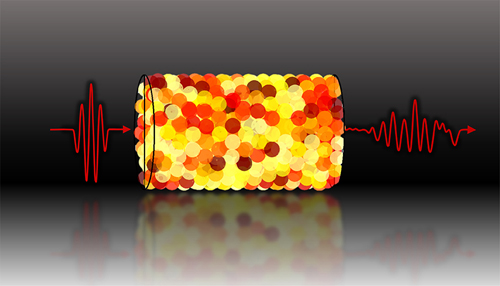
The original Lawrence Livermore National Laboratory news release by Lynda L. Seaver can be read here.
Stress wave propagation through granular material is important for detecting the magnitude of earthquakes, locating oil and gas reservoirs, designing acoustic insulation and designing materials for compacting powders. A team of researchers from Johns Hopkins University and Lawrence Livermore National Laboratory (LLNL), including LLNL physicist Eric Herbold analyzed x-ray data obtained at the U.S. Department of Energy’s Advanced Photon Source (APS) to show that velocity scaling and dispersion in wave transmission is based on grainy particle arrangements and chains of force between them, while reduction of wave intensity is caused mainly from grainy particle arrangements alone. The research appears in the journal Proceedings of the National Academy of Sciences.
“The mechanisms we investigate have been used to explain earthquake triggering, but also are important for accurately pressing explosive powders,” Herbold said. “The pharmaceutical industry is very interested in how powder gets compacted as well as the mining, farming (literal grains) and construction (slope stability, etc.) sectors.”
Structure-property relations of granular materials are governed by the arrangement of particles and the chains of forces between them. These relations enable design of wave damping materials and non-destructive testing technologies. Wave transmission in granular materials has been studied extensively and demonstrates unique features: power-law velocity scaling, dispersion and attenuation (the reduction of the amplitude of a signal, electric current or other oscillation).
Earlier research, dating back to the late 1950s, described “what” may be happening to the material underlying wave propagation, but the new research provides evidence for “why.”
“The novel experimental aspect of this work is the use of in situ x-ray measurements to obtain packing structure, particle stress and inter-particle forces throughout a granular material during the simultaneous measurement of ultrasound transmission,” said Ryan Hurley, a former LLNL postdoc and now an assistant professor of mechanical engineering at Johns Hopkins University. Hurley also is a lead author of the paper. “These measurements are the highest fidelity dataset to date investigating ultrasound, forces and structure in granular materials.”
The x-ray computed tomography and three-dimensional x-ray diffraction measurements were obtained at X-ray Science Division (XSD) 1-ID-E beamline at the APS, an Office of Science user facility at Argonne National Laboratory. The beamline is operated by the XSD Materials Physics and Engineering Group.
“These experiments, along with the supporting simulations, allow us to reveal why wave speeds in granular materials change as a function of pressure and to quantify the effects of particular particle-scale phenomena on macroscopic wave behavior,“ said Chongpu Zhai, a Johns Hopkins University postdoc who led the data analysis efforts and was first author on the paper.
The research provides new insight into time- and frequency-domain features of wave propagation in randomly packed grainy materials, shedding light on the fundamental mechanisms controlling wave velocities, dispersion, and attenuation in these systems.
See: Chongpu Zhai1, Eric B. Herbold2, and Ryan C. Hurley1,2*, “The influence of packing structure and interparticle forces on ultrasound transmission in granular media,” Proc. Natl. Acad. Sci. U.S.A. 117(28), 16234 (July 14, 2020). DOI: 10.1073/pnas.2004356117
Author affiliations: 1Johns Hopkins University, 2Lawrence Livermore National Laboratory
Correspondence: *[email protected]
C.Z. and R.C.H. acknowledge support from The Johns Hopkins University’s Whiting School of Engineering. E.B.H. and R.C.H. acknowledge support for the design and construction of the load frame from Lawrence Livermore National Laboratory’s Laboratory Directed Research and Development Program Grant 17-LW-009. We thank J. Almer, P. Kenesei, and J.-S. Park (all APS) for help in executing the experiments. We acknowledge the APS for synchrotron beam time under proposal GUP-59127. This research used resources of the Advanced Photon Source, a U.S. Department of Energy (DOE) Office of Science User Facility operated for the DOE Office of Science by Argonne National Laboratory under Contract No. DE-AC02-06CH11357.
The U.S. Department of Energy's APS is one of the world’s most productive x-ray light source facilities. Each year, the APS provides high-brightness x-ray beams to a diverse community of more than 5,000 researchers in materials science, chemistry, condensed matter physics, the life and environmental sciences, and applied research. Researchers using the APS produce over 2,000 publications each year detailing impactful discoveries, and solve more vital biological protein structures than users of any other x-ray light source research facility. APS x-rays are ideally suited for explorations of materials and biological structures; elemental distribution; chemical, magnetic, electronic states; and a wide range of technologically important engineering systems from batteries to fuel injector sprays, all of which are the foundations of our nation’s economic, technological, and physical well-being.
Argonne National Laboratory seeks solutions to pressing national problems in science and technology. The nation's first national laboratory, Argonne conducts leading-edge basic and applied scientific research in virtually every scientific discipline. Argonne researchers work closely with researchers from hundreds of companies, universities, and federal, state and municipal agencies to help them solve their specific problems, advance America's scientific leadership and prepare the nation for a better future. With employees from more than 60 nations, Argonne is managed by UChicago Argonne, LLC, for the U.S. DOE Office of Science.
The U.S. Department of Energy's Office of Science is the single largest supporter of basic research in the physical sciences in the United States and is working to address some of the most pressing challenges of our time. For more information, visit the Office of Science website.
